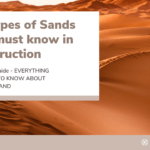While you have got questions about asphalt coverage like how much will a ton or asphalt cover or how much does a ton of asphalt color or calculate coverage of 1 ton asphalt.
In our today’s post, I’ve shared with you asphalt calculate that will help you easily calculate the coverage of 1 ton asphalt in squares of area.

One ton of Asphalt
Asphalt is a versatile construction material that behaves somewhat like concrete. It’s created by blending together various ingredients: rocks, sand, and a special substance called bitumen. You’ve probably seen it before – those black surfaces on roads, highways, parking lots, and even sidewalks. We commonly call it “Asphalt” or “blacktop.”
Think of bitumen as the glue that holds everything together in asphalt. It’s similar to how cement works in regular concrete, binding all the other materials to form a solid pavement.
Also Read: Asphalt concrete – Types – Mix Design – Price – PDF
Now, let’s tackle a common question: How much area can one ton of asphalt cover?
Well, that depends on the project’s size. Asphalt typically has a dark black color, mainly because of the black, gooey bitumen it contains. In the United States, a popular type of asphalt used for paving is called “hot mix asphalt” or simply “blacktop.”
If you’re planning a new construction project involving asphalt, you’ll need to calculate how much asphalt is required. Asphalt is usually measured in cubic yards or tons, and the amount you’ll need depends on your specific project’s needs.
Density of different types of Asphalt
A cubic yard of hot mix asphalt weighs about 2.025 tons or around 4050 pounds, on average. If we’re talking about asphalt millings or milled reclaimed asphalt pavement (RAP), they weigh approximately 3240 to 3780 pounds per yard. That’s roughly equal to 120 to 140 pounds per cubic foot.
Now, let’s think about how thick asphalt should be for different purposes. For a regular home driveway, a thickness of 2.5 to 3 inches is usually enough. However, if it’s a busy area with a mix of uses, like a commercial property, you might need a thicker layer of compacted asphalt, around 4 inches or even more. And for lighter-duty parking lots, you can get by with 1.5 to 2 inches of compacted hot mix asphalt applied to the subgrade.
This way, the road or pavement can handle the specific needs of the place it’s meant for, whether it’s your home driveway or a bustling parking lot.
Also Read: Mastic Asphalt Flooring (Preparation, Construction Process)
How much is a ton of Asphalt? – The Cost
You can usually buy a ton of asphalt for about $40 to $80. It’s quite heavy, weighing around 2000 pounds. This amount of asphalt will give you roughly half a cubic yard (which is like 14 cubic feet in volume), and it can cover an area of about 80 square feet when you spread it out to a standard depth of 4 inches. So, if you’re planning to work with asphalt, knowing these numbers can help you figure out how much you’ll need and what it might cost.
How much will a ton of asphalt cover?
One yard of asphalt weighs about 4,050 pounds, and a ton of asphalt is approximately 2,000 pounds.
To figure out how many cubic yards are in one ton of asphalt, you can simply divide the weight of one ton of asphalt by the weight of one yard of asphalt, like this: 2,000 divided by 4,050 equals approximately 0.5 yards.
And because 1 yard equals 27 cubic feet, this means you have roughly 13.5 cubic feet of asphalt in one ton.
Now, let’s talk about how much area this asphalt can cover at different thicknesses. If you spread it 3 inches thick, it can cover 54 square feet. If you go thinner at 1 inch, it covers 162 square feet.
Going even thinner, at 1/2 inch, it can cover 324 square feet. But if you need a thicker layer, like 1 1/2 inches, it will cover 108 square feet. For 2 inches thick, you’ll get 80 square feet.
Going thicker still, at 2 1/2 inches, it covers 65 square feet. And if you want a really solid 4-inch layer, it can cover 40 square feet.
To calculate how much area one ton of asphalt can cover for your project, you divide the 13.5 cubic feet by the thickness in feet that you want. This will give you the coverage in square feet.
Let’s break down how much area one ton of asphalt can cover when it’s spread 1/2 inches thick:
One ton of asphalt covers:
½” or 12.7 mm thick = 95 SqM
1” or 25.4 mm thick = 48 SqM
2” or 50.8 mm thick = 24 SqM
4” or 101.6 mm thick = 12 SqM
One ton asphalt coverage at 1/2 inches thick
First, we need to convert 1/2 inch into feet. To do that, we divide 0.5 by 12 (because there are 12 inches in a foot), and we get 0.0416 feet.
Now, the amount of space that one ton of asphalt can cover at this thickness is about 13.5 square feet.
To find out how many square feet one ton of asphalt can cover, we divide 13.5 by 0.0416, and it equals approximately 324 square feet.
If we want to know the coverage in square yards, we take that 324 square feet and divide it by 9 (since 1 square yard equals 9 square feet), and we get 36 square yards.
So, when you spread one ton of asphalt at a 1/2-inch thickness, it can cover around 324 square feet or 36 square yards of area.
Also Read: Gravel limestone – What Is Better for Driveways?
One ton asphalt coverage at 1 inches thick
Let’s figure out how much area one ton of asphalt can cover when it’s spread to a thickness of 1 inch:
First, we need to convert 1 inch into feet. To do that, we divide 1 by 12 (since there are 12 inches in a foot), and we get 0.0833 feet.
Now, one ton of asphalt can cover an area of about 13.5 square feet at this thickness.
To calculate how many square feet one ton of asphalt covers, we divide 13.5 by 0.0833, which equals approximately 162 square feet.
If we want to know the coverage in square yards, we take that 162 square feet and divide it by 9 (since 1 square yard equals 9 square feet), and we get 18 square yards.
So, when you spread one ton of asphalt at a 1-inch thickness, it can cover around 162 square feet or 18 square yards of area.
One ton asphalt coverage at 1 1/2 inches thick
Let’s figure out how much area one ton of asphalt can cover when it’s spread to a thickness of 1 1/2 inches:
First, we need to convert 1 1/2 inches into feet. To do that, we divide 1.5 by 12 (because there are 12 inches in a foot), and we get 0.125 feet.
Now, one ton of asphalt can cover an area of about 13.5 square feet at this thickness.
To calculate how many square feet one ton of asphalt covers, we divide 13.5 by 0.125, which equals 108 square feet.
If we want to know the coverage in square yards, we take that 108 square feet and divide it by 9 (since 1 square yard equals 9 square feet), and we get 12 square yards.
So, when you spread one ton of asphalt at a thickness of 1 1/2 inches, it can cover around 108 square feet or 12 square yards of area.
One ton asphalt coverage at 2 inches thick
Let’s find out how much area one ton of asphalt can cover when it’s spread to a thickness of 2 inches:
First, we need to convert 2 inches into feet. To do that, we divide 2 by 12 (since there are 12 inches in a foot), and we get 0.166 feet.
Now, one ton of asphalt can cover an area of about 13.5 square feet at this thickness.
To calculate how many square feet one ton of asphalt covers, we divide 13.5 by 0.166, which equals approximately 80 square feet.
If we want to know the coverage in square yards, we take that 80 square feet and divide it by 9 (since 1 square yard equals 9 square feet), and we get 9 square yards.
So, when you spread one ton of asphalt at a thickness of 2 inches, it can cover around 80 square feet or 9 square yards of area.
One ton asphalt coverage at 2 1/2 inches thick
Let’s determine how much area one ton of asphalt can cover when it’s spread to a thickness of 2 1/2 inches:
First, we need to convert 2 1/2 inches into feet. To do that, we divide 2.5 by 12 (since there are 12 inches in a foot), and we get approximately 0.208 feet.
Now, one ton of asphalt can cover an area of about 13.5 square feet at this thickness.
To calculate how many square feet one ton of asphalt covers, we divide 13.5 by 0.208, which equals roughly 65 square feet.
If we want to know the coverage in square yards, we take that 65 square feet and divide it by 9 (since 1 square yard equals 9 square feet), and we get approximately 7.2 square yards.
So, when you spread one ton of asphalt at a thickness of 2 1/2 inches, it can cover around 65 square feet or approximately 7.2 square yards of area.
One ton asphalt coverage at 3 inches thick
Let’s figure out how much area one ton of asphalt can cover when it’s spread to a thickness of 3 inches:
First, we need to convert 3 inches into feet. To do that, we divide 3 by 12 (since there are 12 inches in a foot), and we get 0.25 feet.
Now, one ton of asphalt can cover an area of about 13.5 square feet at this thickness.
To calculate how many square feet one ton of asphalt covers, we divide 13.5 by 0.25, which equals 54 square feet.
If we want to know the coverage in square yards, we take that 54 square feet and divide it by 9 (since 1 square yard equals 9 square feet), and we get 6 square yards.
So, when you spread one ton of asphalt at a thickness of 3 inches, it can cover around 54 square feet or 6 square yards of area.
One ton asphalt coverage at 4 inches thick
Let’s determine how much area one ton of asphalt can cover when it’s spread to a thickness of 4 inches:
First, we need to convert 4 inches into feet. To do that, we divide 4 by 12 (since there are 12 inches in a foot), and we get 0.33 feet.
Now, one ton of asphalt can cover an area of about 13.5 square feet at this thickness.
To calculate how many square feet one ton of asphalt covers, we divide 13.5 by 0.33, which equals approximately 40 square feet.
If we want to know the coverage in square yards, we take that 40 square feet and divide it by 9 (since 1 square yard equals 9 square feet), and we get roughly 4.45 square yards.
So, when you spread one ton of asphalt at a thickness of 4 inches, it can cover around 40 square feet or approximately 4.45 square yards of area.
| Thickness (inches) | Thickness (in feet) | Coverage in Square Feet | Coverage in Square Yards |
| 1/2 inches | 0.0416 | 324 | 36 |
| 1 inch | 0.0833 | 162 | 18 |
| 1 1/2 inches | 0.125 | 108 | 12 |
| 2 inches | 0.166 | 80 | 9 |
| 2 1/2 inches | 0.208 | 65 | 7.2 |
| 3 inches | 0.25 | 54 | 6 |
Frequently Asked Questions (FAQs)
What area will 1 ton of tarmac cover?
One ton of tarmac or asphalt typically covers about 80 square feet when laid at a standard thickness of 2 inches.
How much is 10 tons of asphalt?
The cost of 10 tons of asphalt varies depending on location and other factors, but it can range from $600 to $1,200 per 10 tons, on average.
How many tons of asphalt do I need?
The amount of asphalt you need depends on the project and desired thickness. A general guideline is that one ton of asphalt covers about 80 square feet at a 2-inch thickness. Calculate based on your specific project requirements.
How much is 2 tons of asphalt?
The cost of 2 tons of asphalt can vary by location and market conditions but typically falls within the range of $120 to $240 for 2 tons.
How many square meters will 1 ton of asphalt cover?
One ton of asphalt generally covers approximately 7.4 square meters when laid at a thickness of 50 millimeters.
How many tons of asphalt can be placed in a day?
The amount of asphalt that can be placed in a day depends on various factors, including equipment, crew, and project size. On average, a paving crew can lay around 300 to 700 tons of asphalt in a day.
Asphalt Calculator
Check Results
| Calculated Area | 0.000 Square Meters |
|---|---|
| Calculated Volume | 0.000 Cubic Meters |
| Estimated HotMix Required | 0.000 Tons |
| Estimated Cost of Hotmix | $0.00 + GST & Delivery Charge |
Further Read: How Many Bags are in a Pallet of Mulch?



















